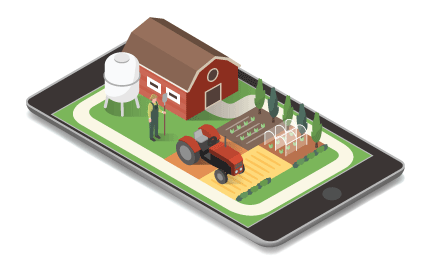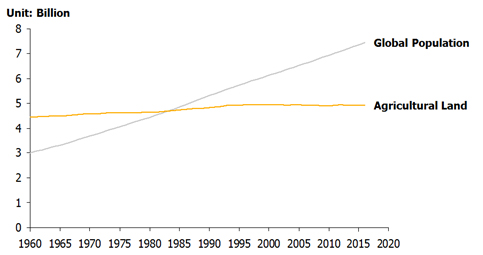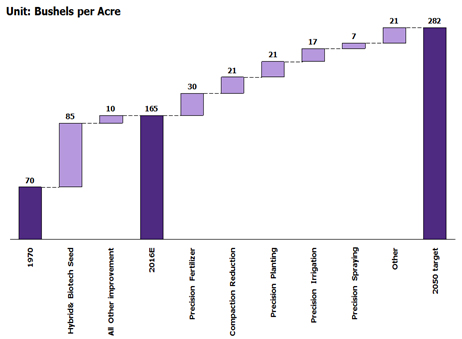Smart farming: Hope for the world, opportunity for Thailand
Author: Pharadon Heemmuden

|
Highlight
|
In the future, demand for agricultural products will increase greatly due to an increasing world population and higher meat consumption per capita. The Food and Agriculture Organization of the United Nations estimates that the world population will increase 35% to 9.7 billion people in 2050. The additional population is about 1.7 times the size of the China’s current population. Higher income per capita has brought about the expansion of the middle class, especially in populous developing countries like China, India, and Indonesia, and helped change consumer behavior towards a preference for better food. Globally, meat consumption per capita is estimated to be increasing by 1.2% annually. This development will hike demand for agricultural products greatly, considering that one kilogram of meat requires about 2-7 kilograms of agricultural products as feed. A case for this claim can be seen in China, as it switched from being an exporter of grains to an importer due to the continuous growth of incomes and meat intake per capita (Figure 1). In 2015 the country had to import 40% of its domestic grain consumption.
The usual agricultural practices will not be able to feed the world, as demand for agricultural products increases while agricultural land remains limited (Figure 2). Farmers should therefore seek new ways to increase production per rai. Today’s agricultural practices are inefficient, with irrigation wasting an estimated 90% of the water used. About 40% of farms globally overuse fertilizers and chemicals, leading to harmful effects on soil quality and consequently yield per rai. At the same time some farms underuse fertilizers, leading to less-than-optimal yields. The agricultural sector has been developing genetic modification and cross species breeding techniques to obtain seeds that can endure harsher environments and provide higher yields, but these technologies might not be up to the challenge of raising agricultural products by 70% over the next 35 years.
More agricultural technologies should be adopted in order to enable the agricultural sector to feed an increasing world population. One of the technologies that it is hoped will increase yield per rai is precision agriculture. Precision agriculture approaches agriculture practices like industrial operations, in that it aims to maximize yield per rai by employing precise watering and fertilizing techniques using data obtained by closely monitoring related variables, such as humidity and mineral levels in soil (Figure 3). Precision agriculture includes 1.) precision planting, which involves planting seeds with different growth rates depending on the properties of the soil and matching seed genetics with soil conditions 2.) precision fertilizing, which modulates fertilization according to different soil properties 3.) precision spraying, which identifies highly weed-infested areas for emphasis spraying, leading to a 60% reduction in the use of chemical pesticides and 4.) precision irrigation, that uses soil moisture and weather data to determine the rate of irrigation to keep soil moisture at suitable levels.
One of the farms successful in adopting precision agriculture is Jones Enterprises, with about 58,000 acres of farmland in the US. Jones Enterprise uses multi-hybrid seed planters to divide seeds into groups that requires less water and groups that requires the usual amount. This practice helps increase corn yields to 12 bushels per acre. Currently, Jones Enterprise is assessing the employment of precision fertilizing, which agricultural technology company Trimble estimates will decrease costs by 10% and improve crop yields by 10%.
Data processing systems with data collection from drones and satellites will help farmers devise better production and harvest plans to increase yield per rai. Data collected in sensors connected to a precision agricultural system along with data from drones and satellites are gathered in a database for algorithm analysis. This enables farmers to monitor their lands in real time and respond to changes in advance. For example, farmers can change planting or harvesting times during high-risk weather conditions. One of the products offering comprehensive agricultural data management is called ConnectedFarm by Trimble. The tool provides weather forecast data and tracks crop and soil quality, as well as providing summary reports on crop quality between seasons, monitoring fields via satellite and calculating field profitability.
More advanced technologies, such as small self-driving tractors, will help decrease land damage and improve production. Smaller tractors help mitigate the effects of the weight of bigger tractors and self-operating machines will help address the shrinking labor force in the agricultural sector. The weight of large tractors leads to greater soil compaction, which reduces space for water, air, and soil particles and affects crop growth. Using a smaller tractor could help increase yield per rai by 10-15%. Another technology under development is the use of tractors or harvesting machines that do not require operators, meaning that changing to smaller tractors does not result in an increased labor requirement. This development is especially relevant to the current state of the global labor market, where the agricultural sector has fewer young workers. The USDA has found that the average age of American farmers is 58 years old and has been continuously increasing for the last 30 years.
Thailand has the potential to increase its agricultural exports by using these technologies to increase production. Lower rates of technology adoption in the Thai agricultural sector have kept yield per rai low. The average corn yield in Thailand is 644 kilograms per rai compared to 1,691 kilograms per rai in the US, where farmers embrace more agriculture technology. More usage of agricultural technology will help raise production and export values in the future. One of the reasons Thailand’s farmers shy away from agricultural technology is that most agricultural plots are small scale, making more advanced technology not worth the investment. The government should support nearby farmers in merging their lands into large-scale farms, such as getting rid of paddy-field ridges and farming together in bigger rice plots. The shift to larger-scale farming will be one of the key factors in developing the Thai agricultural sector in the future. In the past, Japan has succeeded in supporting large-scale farming by using financial incentive programs to persuade farmers to consolidate their fields. While the Thai government has started to adopt a similar policy, the response has been modest, with only 840 thousand rais responding to the paddy-field consolidation effort. Regarding agricultural technology, initially the government should help guide farmers and expose them to economically viable tools.
|
|
|
|
|
Figure 1: China’s meat consumption

Source: EIC analysis based on data from Food and Agriculture Organization of the United Nations
Figure 2: Global agricultural land vs. global population

Source: EIC analysis based on data from the Food and Agriculture Organization of the United Nations
Figure 3: Projection of the effects of technology on corn yield per acre in the US

Source: EIC analysis based on data from Goldman Sachs Global Investment Research and the United States Department of Agriculture